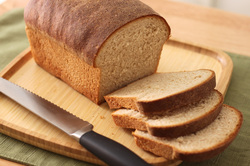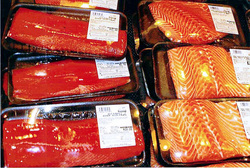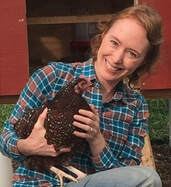This week, we move on to the second half of the list. We're starting off with a doozy....
Banned Food #5: Chicken Containing Arsenic
Most people are aware of arsenic as a potent toxin (commonly used to off people in mystery novels), but did you know that it is fed to the conventionally raised chickens that end up on your dinner table? Arsenic-based drugs are often added to chicken feed to make the chickens gain weight faster, and also to make the meat appear pinker (corn-fed chickens usually have very pale flesh since they don't get to eat their natural diet of green grass and plants, which makes the meat of pasture-raised chickens naturally pink and fresh looking).
Arsenic has never been approved as a safe additive to animal feed in the European Union, and several groups are lobbying the FDA asking for its removal in the U.S. as well. But until that happens, it's up to you to protect yourself against this toxic carcinogen.
How to Avoid It:

Potassium bromate is commonly used in commercial bread and other baked goods, as an additive which is supposed to make the dough more elastic. However, some well-known companies, such as Pepperidge Farm, have opted not to use bromated flour, and if you've ever made bread at home, you probably did it without bromide just fine.
Over-consumption of bromide has been linked to thyroid issues, kidney and nervous system damage, and even cancer. The use of potassium bromate in foods is currently banned in China, Canada, and the European Union.
How to Avoid It:
Bake your own bread at home from scratch, or purchase from companies that don't use potassium bromide in their flours. Ask at your local bakery whether they add this to their baked goods, and read the ingredient labels on any packaged bread or baked items before buying.
Banned Food #8: Olestra or Olean
This calorie-free fat substitute is used in some fat-free snack foods such as potato chips. Invented by Proctor & Gamble to satisfy people's mistaken belief that fat-free means healthy, it has gained notoriety due to customer complaints of side effects such as "anal leakage" - a not-so-lovely sounding symptom. Studies have shown other side effects of consuming this substance include gastrointestinal distress, weight gain, and interference with nutrient absorption (which the FDA is aware of, and therefore requires that foods containing Olestra be fortified with fat-soluble vitamins such as A, D, E, and K).*
Olestra/Olean are banned in the UK and Canada.
How to Avoid It:
Don't eat processed junk or fast foods labeled "fat-free." They may have less fat, but typically they contain a lot of other not-so-nice ingredients to make up for the lack of flavor from the missing fat. Choose naturally fat-free snacks instead, such as fruit or vegetables, or snacks with good fats, such as nuts. And if you really must have a nice crunchy handful of potato chips once in a while, it's perfectly okay to indulge in the full-fat version as long as it's only on special occasions and not a daily occurrence!
Banned Food #9: BHA & BHT (Preservatives)
These nasty sounding chemicals - butylated hydroxyanisole and butylated hydroxytoluene - are frequently used as preservatives in many different processed foods, from cereal to chewing gum to dehydrated potatoes, butter-flavored spreads, beer, and more.
Their side effects can be serious, ranging from allergic reactions to organ system toxicity, and even the US Department of Health & Human Services lists BHA as "reasonably anticipated to be a human carcinogen."
BHA and BHT are banned in parts of the European Union and Japan, and the UK does not allow BHA to be used in infant foods.
How to Avoid It:
As previously mentioned, the easiest way to avoid this one of course is to not eat processed foods! The whole, real versions are always better for you - and they taste better too. If you can't give up processed foods entirely, at least learn to recognize these chemicals on ingredient labels, and seek out BHA- and BHT-free versions.
Banned Food #10: Farm-Raised Salmon
 Wild Salmon - Left; Farmed Salmon - Right.
Wild Salmon - Left; Farmed Salmon - Right. It all depends (as with just about any other food) on how it's raised. While salmon is commonly known as a "super-food" due to its high content of healthy fatty acids, the farm-raised kind is not at all the same animal.
Firstly, if you have done any research on how fish is farmed, you may already know that the conditions are pretty horrible (kind of like any other industrially farmed meat animal) - with fish being pumped full of antibiotics and other drugs just to keep them alive in very unsanitary living quarters.
Farmed fish is typically fed grain, which it is ill-equipped to digest (just as cows are), and this leads to disease, as well as to the meat being an unappetizing gray color. Therefore, salmon is fed synthetic astaxanthin made from petrochemicals (which actually has not been approved for human consumption). This synthetic form of astaxanthin has several known toxicities, and could even potentially harm your eyesight. However, it does give the fish a pink color that consumers find more appealing.
The sale of farmed fish fed/colored with astaxanthin is banned in Australia and New Zealand.
How to Avoid It:
Salmon is still a very healthy fish to eat if you choose the wild kind, but how do you know if fish is wild or farm-raised? Sometimes it may be labeled, but you can also learn to recognize it for yourself. For wild-caught salmon, look for bright red flesh, with very thin white stripes. If the meat is a paler pink, with wider stripes, it's probably farmed (most salmon served in American restaurants is farmed).
When it comes to labeling, if it is labeled "Atlantic" salmon, it's probably farmed. "Alaskan" or "Sockeye" salmon is more likely to be wild.
So there you have it! The top 10 banned foods, which we still eat on a regular basis here in the good old U.S. of A.!
Hopefully these two posts will give you pause next time you go to pick up that package of meat, bag of chips, or can of soda, and help you remember that YOU are in control of your health, and that you can make healthy choices for yourself and your family, each and every time that you shop.
And of course, stay tuned to this blog, where we will always do our best to expose the TRUTH about health, and keep you on the right track!
* You can find other information on these foods in various places, but most of the stats and facts in this post are sourced from this article on www.eatlocalgrown.com.



 RSS Feed
RSS Feed